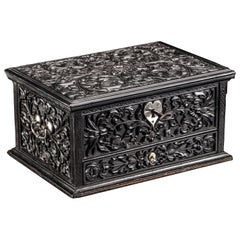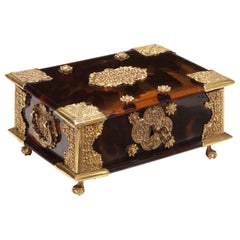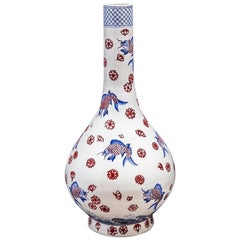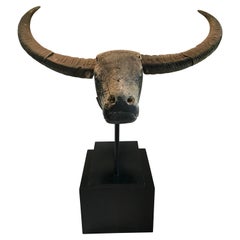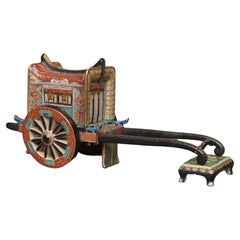Amsterdam - Antiquities
20
to
1
767
450
20
20
20
10
9
1
1
11
10
5
4
4
20
13
13
5
5
Item Ships From: Amsterdam
Japanese Edo-period gosho’ningyô 御所人形 (palace doll) of plump, seated child
Located in Amsterdam, NL
A charming gosho’ningyô (palace doll) of plump, seated child with a brilliant white skin and a small delicately elegant face, reminiscent of a young noble. The doll is playfully rais...
Category
Early 19th Century Japanese Antique Amsterdam - Antiquities
Materials
Paste, Silk, Paint
A Dutch colonial ebony box with silver mounts
Located in Amsterdam, NL
Batavia (Jakarta), or Sri Lanka, circa 1680-1720
The document or money box is densely carved with fine scrolling vines and lotus flowers. It has a charming heart- shapes silver lock...
Category
Late 17th Century Indonesian Dutch Colonial Antique Amsterdam - Antiquities
Materials
Silver
A small Dutch colonial Indonesian tortoiseshell betel box with gold mounts
Located in Amsterdam, NL
Jakarta (Batavia), 18th century, apparently unmarked
L. 14 x W. 9.5 x H. 4.7 cm
Before settling down to business in the former Dutch East Indies, sirih had to be offered in the mos...
Category
Late 18th Century Indonesian Dutch Colonial Antique Amsterdam - Antiquities
Materials
Gold
A large Dutch colonial ebony cabinet with brass mounts
Located in Amsterdam, NL
A Dutch colonial ebony cabinet with brass mounts on contemporary black steel frame
Batavia (Jakarta), 2nd half 17th century
The cabinet has two ...
Category
Mid-17th Century Indonesian Dutch Colonial Antique Amsterdam - Antiquities
Materials
Brass
Large pair of Japanese ‘Jyôka’ 常花, sets of gilded lotus flowers and -leaves.
Located in Amsterdam, NL
A spectacular pair of black glass vases each adorned with 13 large handmade gilded wooden lotus flowers and -leaves with refined details.
Such a set is known as ‘Jyôka’, and are typically positioned on or beside an altar in a Buddhist temple.
The lotus flowers are at different stages of their life (unfurled lotus leaves, buds and blooms) and symbolize the journey towards Buddhist enlightenment.
What sets this pair apart is its size; it is considerably larger than many similar sets, making it a rare find. As well as that it has such an extensive array of gilded flowers.
The flowers, which are detachable, allow for customizable arrangements within the vases.
Period: Japan – lotuses...
Category
Late 19th Century Japanese Antique Amsterdam - Antiquities
Materials
Glass, Giltwood, Lacquer
A 17th century Dutch-colonial ebony two-door VOC cabinet with silver mounts
Located in Amsterdam, NL
A Dutch-colonial ebony two-door cabinet with silver mounts
Coromandel Coast, probably Masulipatnam, circa 1650-1680, the silver later
H. 64.5 x W. 75 x D. 46 cm
The present cabinet...
Category
17th Century Indian Dutch Colonial Antique Amsterdam - Antiquities
Materials
Silver
An Indian colonial tortoiseshell veneered teak portable two-door cabinet
Located in Amsterdam, NL
Mughal India, Gujarat, 2nd half 17th century
H. 22.4 x W. 30.3 x D. 26.8 cm
This small cabinet has six drawers behind two doors. Originally ordered by the Portuguese, and made afte...
Category
17th Century Indian Antique Amsterdam - Antiquities
Materials
Tortoise Shell, Teak
Rare set of 2 Japanese suits-of-armour, complete with 2 matching folding screens
Located in Amsterdam, NL
Important unique set of two suits-of-armour (yoroi), complete with two high six-panel screens, that belong together as is indicated by the used family crests (mon). Two crests are used, both belonging to the Nakagawa family of Oka Castle, Ôita prefecture on Kyûshû.
They are:
– the Nakagawa-kurusu, a circle depicting a Celtic-like cross through a ring.
The cross was originally a Christian symbol but after the ban on Christianity in Japan the use of a hidden cross in family crests could continue.
– the Nakagawa-kashiwa, two leaves of the Japanese Emperor Oak turned to each other (dakikashiwa mon).
The remarkable aspect of this ensemble is the presence of matching crests on both the yoroi and the accompanying folding screens. The kurusu and kashiwa crests adorning the yoroi are elegantly replicated on the screens, providing compelling evidence that these pieces form a harmonious and unified set. This exceptional cohesion between the armour and screens further enhances their artistic and historical value.
After the warlord Toyotomi Hideyoshi (1537-1598) had interfered in the battle between the Lord of Bungo Province Ôtomo Yoshi-mune (1558-1605) and the Shimazu of Hyûga Province, he split the Bungo Province in a number of small fiefs and transferred in 1594 Nakagawa Hideshige (1570-1612) from Miki Castle
in the Harima Fief to Oka Castle in Kyûshû.
The Nakagawa family stayed in possession of Oka Castle till the abolishment of the military use of castles in 1873. In 1884 the Nakagawa family received the title of Count (a title in use till the abolishment of aristocracy in 1947).
After the Nakagawa’s left, the castle and the building soon dilapidated and is now known as Oka Castle Ruins. The castle is located in Taketa Village part of Taketa Town in Ôita Province on Kyûshû.
> Set of two tall byôbu (folding screens),
painted with large red jinmaku (camp enclosure curtain) on a gold leaf ground. The curtains show both crests of the Nakagawa family: one screen depicts two Nakagawa-kurusu crests next to a Nakagawa-kashi crest in the middle, and the other shows the symbols the other way round.
Dimensions:
Total width 148.66 in/377.6 cm (2 x 25.35 in/64.4 cm, 4 x 24.48 in/62.2 cm); Height 72.63 in/184.5 cm.
Period: Japan – Late Edo period (First half 19th century), and maybe even older.
> Yoroi with Nakagawa-kashiwa crest:
A Japanese black lacquered suit-of-armour (yoroi) completely laced with orange cords (kuro’urushinuri hi’ito odoshi nimai’dô’maru).
A thirty-two plate suji’bachi kabuto (helmet with raised ridges) with in front a maedate (fore crest) -with traces of gilding- in the shape of flames, resembling a mythical flaming bird flying down. The fukikaeshi (face guards) and the mabizashi (visor) have the Nakagawa-kashiwa crest in gold maki-e lacquer.
Five curved ‘itazane’-plate neck guards (shikoro) laced with orange cords.
Together with an ‘angry man...
Category
18th Century Japanese Antique Amsterdam - Antiquities
Materials
Gold Leaf, Iron, Metal
Signed Japanese Edo suji’bachi kabuto (helmet) with a moon & cloud maedate
Located in Amsterdam, NL
An antique, outstanding signed suji’bachi kabuto (helmet with ridges) surmounted by a gilt metal maedate (forecrest) shaped like a full moon emerging from the clouds heightened by a ...
Category
Early 19th Century Japanese Antique Amsterdam - Antiquities
Materials
Metal, Iron
Royal Indonesian Buginese Gold and Buffalo Horn Badek Dagger
Located in Amsterdam, NL
A Royal Indonesian Buginese gold and buffalo horn badek dagger
Indonesia, Sulawesi, 1st half 18th century
L. 54 cm
?
The solid gold scabbard is inscribed with a magic square,...
Category
Mid-18th Century Indonesian Antique Amsterdam - Antiquities
Materials
Gold
Pair of Japanese Carved Wooden Temple Ornaments 木鼻 'Kibana' Shaped like Baku 獏
Located in Amsterdam, NL
A lovely pair of very detailed carved wooden temple ornaments (kibana) in the shape of elephant-like mythical creatures known as ‘Baku’.
Baku are Japan...
Category
Early 19th Century Japanese Antique Amsterdam - Antiquities
Materials
Wood
Antique Bronze Vase Cloisonné Japan Meiji 19th Century Japanese
Located in Amsterdam, Noord Holland
Absolute top Quality vase with superb decoration of flowers
Cloisonné is a way of enamelling an object, (typically made of copper) whereby fine wires are used to delineate the dec...
Category
19th Century Japanese Meiji Antique Amsterdam - Antiquities
Materials
Porcelain
Rare Ainu Navy Cotton Robe Featuring Wide Appliquéd Geometric Bands, Japan
Located in Amsterdam, NL
Rare Japanese Ainu navy blue cotton robe featuring wide red and white appliquéd bands along the edges with embroidered geometric shapes.
Acquired from an Ainu education center in th...
Category
Early 20th Century Japanese Amsterdam - Antiquities
Materials
Cotton
Portuguese-colonial Japanese Namban lacquer Vargueno Cabinet, circa 1600
Located in Amsterdam, NL
A Portuguese-colonial Japanese Namban lacquer vargueno cabinet
Momoyama period, circa 1600
H. 43 x W. 64.5 x D. 36 cm
Wood, black lacquered and deco...
Category
Early 1600s Japanese Antique Amsterdam - Antiquities
Materials
Gold, Brass
18th-century Dutch-colonial Peranakan mother-of-pearl casket with silver mounts
Located in Amsterdam, NL
An Indonesian Peranakan mother-of-pearl inlaid mastic sirih casket with silver mounts
Jakarta (Batavia), circa 1720-1730, the silver hinges marked for Batavia, maker’s mark HS or SH...
Category
Mid-18th Century Indonesian Dutch Colonial Antique Amsterdam - Antiquities
Materials
Silver
Pair of Japanese High Quality Chôshi 銚子 'Sake Ewers', Signed 'Sei’ô' 晴王
Located in Amsterdam, NL
Pair of high quality cast iron chôshi (sake ewers) with a detailed lacquered lid. Its body with a refined embossed design of a bird of prey (môchô) perched o...
Category
Late 19th Century Japanese Antique Amsterdam - Antiquities
Materials
Iron
Red lacquer Festival Flag Support abundantly inlaid with mother-of-pearl, Japan
Located in Amsterdam, NL
Rare museum-worthy Japanese lacquered wooden festival support for a flag. In feudal Japan this kind of supports sat on the back of a horse or ox during pr...
Category
19th Century Japanese Antique Amsterdam - Antiquities
Materials
Metal, Bronze, Copper
Japanese Kamakura/Muromachi Period Cedarwood Buddhist Priest, 12th-15th Century
Located in Amsterdam, NL
Seated Buddhist priest
Japan, Kamakura period (1185-1333) or Muromachi period (1333-1573).
Different carved hollow blocks of cedar wood joined togeth...
Category
15th Century and Earlier Japanese Antique Amsterdam - Antiquities
Materials
Cedar
Antique Iwayaki Earthenware Edo Incense Burner of a Turtle 19th Century Japan, J
Located in Amsterdam, Noord Holland
Nicely made and large incense burner or Okimono of a turtle. In earthenware with nice patina. Shimane Prefecture Iwayaki (Nagahama Yaki) Turtle figurine. The head and part of the bac...
Category
19th Century Japanese Edo Antique Amsterdam - Antiquities
Materials
Earthenware
Antique ca 1900 Japanese Satsuma Obiyama Candle Holders Richly Decorated Marked
Located in Amsterdam, Noord Holland
Description
Sharing with you is this nice pair of Japanese Satsuma candle holders, Obiyama, Meiji/Taisho period. Absolute top quality pieces.
...
Category
19th Century Japanese Meiji Antique Amsterdam - Antiquities
Materials
Porcelain
Related Items
Large Japanese Imari Vase
By Imari Porcelain
Located in West Palm Beach, FL
A large Japanese Imari vase
Of baluster form with a long narrow neck enameled in underglaze blue and iron red with catfish and flowers; signed.
M...
Category
20th Century Amsterdam - Antiquities
Materials
Ceramic
Large 19th Century Indonesian Sculpture of a Bull
Located in Stockton, NJ
Massive and rare early 19th century Indonesian ship bowsprit. Originally a decoration on the front of a ship. Carved wood bull with natural horns. Museum mou...
Category
Early 19th Century Asian Antique Amsterdam - Antiquities
Materials
Iron
Late 19th Century Silver Deer Box from India
Located in Marseille, FR
Late 19th century silver deer box from India.
Category
Late 19th Century Indian Anglo-Indian Antique Amsterdam - Antiquities
Materials
Britannia Standard Silver
Indonesian old small wooden workbench/20th century/exhibition stand
Located in Sammu-shi, Chiba
I believe this is made in Indonesia.
Around the 20th century.
It seems that it was used as a workbench because there are fine beating marks and cuts.
The top surface and corners are...
Category
20th Century Indonesian Other Amsterdam - Antiquities
Materials
Wood
Porcelain Japanese Circular Blue and White Box with Cover
Located in Oklahoma City, OK
Beautiful round porcelain dish or circular box with a cover in blue and white. This circular chinoiserie box with a cover is finely decorated with a crisp blue and white hue. This di...
Category
20th Century Japanese Chinoiserie Amsterdam - Antiquities
Materials
Ceramic, Porcelain
17th-18th Century, Edo, A Set of Japanese Samurai Armor
Located in Sampantawong, TH
A set of Japanese Samurai armor.
Age: Japan, Edo Period, 17th - 18th Century
Size: Height 190.5 C.M. / Width 60 C.M.
Condition: Nice condition...
Category
17th Century Japanese Antique Amsterdam - Antiquities
Materials
Metal
19th Century Chinese Apothecary Medicine Cabinet with 45 Drawers
Located in Kastrup, DK
Beautiful Chinese apothecary medicine chests dating to circa 1840-1860 from the Shanxi province, China.
45 drawers and original lacquer. ...
Category
Mid-19th Century Chinese Qing Antique Amsterdam - Antiquities
Materials
Metal
Ichimatsu Ningyo Doll from Japan Around 1890
Located in Hamburg, DE
Ichimatsu Ningyo doll is a Japanese shell limestone doll from the Meiji period. The doll body as well as the head, forearms, hands, legs and feet are made...
Category
1890s Japanese Meiji Antique Amsterdam - Antiquities
Materials
Limestone
"Blanc de Chine" Guanyin with Lotus Flower Porcelain, circa 1900
Located in Beuzevillette, FR
Porcelain "Blanc de Chine" Statuette of a Guanyin stand on a lotus leaf, holding a lotus flower.
China.
Early 20th century.
Category
Early 20th Century Chinese Chinoiserie Amsterdam - Antiquities
Large Pair of Fine Quality Japanese Meiji Mixed Metal Vases - Antique, c.1910
Located in Wisbech, Cambridgeshire
Antique Large Pair of Japanese Bronze Mixed Metal Vases - Exquisite Meiji Period Artist Pieces!
These stunning Japanese bronze mixed metal vases, dating back to the Meiji Period cir...
Category
1910s Japanese Meiji Vintage Amsterdam - Antiquities
Materials
Bronze
1830s Antique Indian Colonial Silver Jug
By Hamilton & Co., Calcutta
Located in Jesmond, Newcastle Upon Tyne
A magnificent, fine and impressive antique Indian colonial silver jug made by Hamilton & Co; part of our dining silverware collection.
This magnificent antique Indian silver jug...
Category
1830s Indian British Colonial Antique Amsterdam - Antiquities
Materials
Silver
Antique Chinese Export Silver Jewellery Box, circa 1895
By Hung Chong & Co.
Located in Jesmond, Newcastle Upon Tyne
An exceptional, fine and impressive antique Chinese Export silver jewellery box; an addition to our collection of boxes and cases
This exceptional antique Chinese Export Silver box has a subtly undulating rectangular form.
The surface of the box has a planished finish and is embellished with an embossed and chased decorated stemmed floral and foliate design to the anterior surface.
The decoration to the body continues to the cover, incorporating plum blossom arrangements and an impressive perched bird motif.
This antique jewellery box is fitted with the original hinged cover.
This exceptional Chinese silver jewellery box is supported by four impressive cast silver feet.
The hallmarks struck to the underside of this fine box include:
Maker's mark: HC (Hung Chong)
Artisan workshop mark: QI CHANG (Shanghai)
NOTE: We are grateful to Adrien von Ferscht for his help in identifying this exceptional antique piece.
Condition
This antique Chinese silver jewellery...
Category
1890s Chinese Antique Amsterdam - Antiquities
Materials
Silver
Previously Available Items
Japanese Kyô’yaki Porcelain Gosho’guruma 御所車 Kôro 香炉 'Incense Burner'
Located in Amsterdam, NL
A wonderful and delicate Kyô’yaki porcelain kôro (incense burner) in the form of a gosho’guruma (ox-drawn carriage for Heian-era nobles).
Constructed in several detachable sections, decorated with geometric and floral designs in green, iron-red, yellow, black enamels and gilt.
The rectangular detachable roof painted and moulded on all four sides with simulated sudare (bamboo blinds...
Category
Early 19th Century Japanese Antique Amsterdam - Antiquities
Materials
Porcelain
Free Shipping
H 7.6 in W 15.56 in D 6.23 in
Japanese Bamboo Ikebana Flower Basket 花籠 'Hanakago' by Wada Waichisai Iii 和田和一斎
By Wada Waichisai Iii
Located in Amsterdam, NL
Beautiful globular wickerwork bamboo ikebana flower basket (hanakago) with a fixed loop handle with a lovey reddish brown patina, by the famous basket maker Wada Waichisai III (1899-1975).
The body is intricately woven with thin susutake (‘smoked bamboo’) bamboo strips using different types of plating. The body is woven in a criss-cross open worked fashion with dense horizontal lines.
Including a separate bamboo segment vase...
Category
20th Century Amsterdam - Antiquities
Materials
Bamboo
Free Shipping
H 21.66 in Dm 10.63 in
Large Antique Bronze Japanese Statue Decorated Shou Lao and Turtle
Located in Amsterdam, Noord Holland
Description
Nicely made artifact dating to the 19th or 20th century. Depicting Shou Lao the god of immortality on a mythical turtle.
---------------------------------------------...
Category
19th Century Japanese Showa Antique Amsterdam - Antiquities
Materials
Bronze
Recently Viewed
View AllMore Ways To Browse
Silver Filigree Fan
Wicker Stroller
Antique European License Plates
Buddha Footprint
Yak Horn
Rolex Bamboo
Bronze Bracelet Cambodia
Agate Incense
Cloisonne Ewer
Jade Belt Hook
Gandharan Bust
Japanese Chochin
Reuge Music Singing Bird Box
Ancient Bactrian Jewelry
Dragon Rolex
Victorian Wicker Baby Carriage
Antique Chinese Embroidered Shoes
Cloisonne Throne

